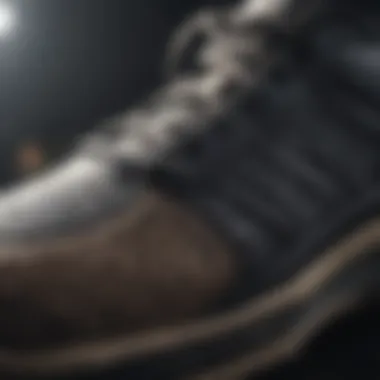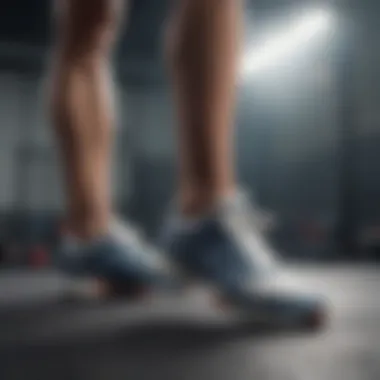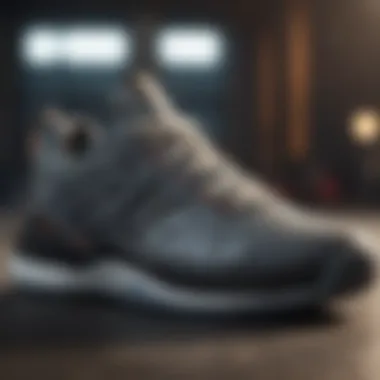Tennis Shoes for CrossFit: Comprehensive Insights


Intro
Selecting tennis shoes for CrossFit is not a trivial task. The demands of CrossFit workouts vary greatly, from high-intensity interval training to weightlifting. Each component requires its own unique set of shoe features. In this article, we will examine the critical elements that define the best tennis shoes for these diverse training modalities.
The shoes designed for CrossFit must provide stability, support, and flexibility. As athletes engage in activities requiring lateral movements, jumping, and heavy lifting, the right footwear is paramount to both performance and injury prevention. This analysis will focus on popular shoe models, highlighting their key features and comparing their performance attributes.
By delving deeper into the specifics of what makes a shoe suitable for CrossFit, athletes can make educated choices that enhance their training experience. We will also summarize actionable insights that readers can easily apply.
Key Takeaways
- Significance of Shoe Design: The design elements of shoes directly influence performance and injury risk during CrossFit workouts.
- Model Comparisons: Different models serve specific needs; knowing the differences aids in choosing suitable footwear for individual workout regimens.
- Awareness of Body Needs: Recognizing the unique demands of the body during CrossFit will assist in selecting the proper footwear.
In-Depth Analysis
Understanding the dynamics of CrossFit is crucial to appreciate the importance of selecting the right tennis shoes. A clear grasp of factors like cushion, grip, support, and overall fit is essential. For example, a shoe with a low drop encourages natural movement and grounding during lifts, while a shoe with cushioning is beneficial for high-impact exercises like jumps or running.
A significant aspect we will cover includes the biomechanics involved in CrossFit training. Various scientific studies underline how improper footwear can lead to overuse injuries. Research indicates that shoes that provide good arch support and stability can reduce these risks.
“Selecting proper footwear can greatly mitigate the risk of injuries, allowing athletes to focus on performance.”
Furthermore, we will consider brand offerings from well-known companies like Nike, Reebok, and Adidas. Each brand specializes in producing shoes with unique attributes that cater to different intensities and movements specific to CrossFit. We will examine key features such as outsole grip, weight distribution, and breathability, which can greatly affect overall training quality.
Ultimately, this article aims to equip health professionals, wellness coaches, nutritionists, fitness trainers, and mindfulness instructors with the knowledge required to guide athletes in their shoe selections. By synthesizing insights throughout this article, readers will gain a comprehensive understanding of how tennis shoes can dramatically impact CrossFit performance and injury risk.
By focusing on specific aspects of tennis shoes and their designs, we can find the best pair to complement our rigorous CrossFit regime.
Understanding CrossFit and Its Demands
Understanding the unique demands of CrossFit is essential for anyone participating in this high-intensity fitness regimen. The nature of CrossFit involves a blend of various workout modalities. This includes elements such as weightlifting, cardiovascular exercises, and gymnastics. Thus, it becomes crucial to choose the right equipment, especially footwear, to optimize performance and reduce the risk of injuries.
What is CrossFit?
CrossFit is a strength and conditioning program based on functional movements performed at high intensity. It is designed to improve overall fitness levels across ten key domains: cardiovascular endurance, stamina, strength, flexibility, power, speed, coordination, agility, balance, and accuracy. Founded in 2000 by Greg Glassman, CrossFit has proliferated into a global phenomenon with gyms known as "boxes". Participants engage in varied workouts that often change daily, known as the Workout of the Day (WOD), which keeps the regimen fresh and challenging.
Physical Demands of CrossFit Workouts
CrossFit workouts can vary significantly in intensity and duration. They often include complex movements such as overhead lifts, burpees, kettlebell swings, and box jumps. This variety demands a lot from the body. For example, a workout may require a combination of strength and endurance, calling for explosive power and lasting stamina. Consequently, athletes may find themselves taxing different muscle groups differently. Because of these physical demands, injuries can occur if not properly managed. Choosing appropriate footwear plays a vital role in ensuring safety and enhancing performance during these workouts.
Importance of Proper Footwear in CrossFit
Having the right footwear can significantly affect an athlete's performance in CrossFit. Proper shoes should provide adequate support for lateral movements, stability during weightlifting, and cushioning for endurance workouts. Here are some critical reasons why proper footwear is important:
- Injury Prevention: A good shoe can help maintain optimal foot and ankle alignment, thereby reducing strain on muscles and joints.
- Supportive Cushioning: Shoes with proper cushioning absorb impact during high-intensity exercises, preventing discomfort and fatigue.
- Sufficient Traction: Effective grip is necessary to handle various surfaces in the gym and avoid slips during dynamic movements.


"Investing in quality footwear tailored for CrossFit can yield tangible improvements in both performance and health."
In summary, understanding CrossFit's demands allows athletes to make informed choices regarding their footwear. This understanding can lead to enhanced performance while minimizing injury risks.
Key Features of Tennis Shoes for CrossFit
Tennis shoes tailored for CrossFit must meet unique demands. The right footwear can enhance performance and minimize injuries. This section details crucial features that distinguish these shoes, considering the workout types and intensity levels involved in CrossFit exercises. Each feature contributes to overall effectiveness and comfort, making informed choices essential.
Support and Stability
Support and stability are paramount in any athletic shoe, particularly for CrossFit. These workouts often involve rapid movements, transitions, and varied foot positioning. A shoe that offers ample support reduces the risk of ankle sprains and injuries. Key elements include a robust heel counter and a snug fit across the midfoot. These characteristics ensure that the foot remains securely positioned during exercises such as squats or jumps.
A well-designed shoe will also have a wider toe box to accommodate natural foot expansion during activity. This design promotes better stability, allowing athletes to lift or sprint effectively. Choose a model that includes features like a firmer sole, which can aid in providing the necessary support while maintaining comfort.
Cushioning and Comfort
Cushioning serves as another critical aspect of tennis shoes for intense workouts. While CrossFit involves high-impact movements, excessive cushioning might impede responsiveness. Therefore, it is vital to find the right balance.
Look for shoes that incorporate responsive foam and lightweight materials. These features promote comfort without sacrificing the feeling of the surface beneath. When choosing shoes, pay attention to the insole as well. A removable insole can offer customization for improved comfort.
Good cushioning can aid recovery too, absorbing impact during movements like burpees or box jumps. Properly cushioned shoes can enhance endurance by reducing fatigue during longer training sessions.
Traction and Durability
Traction refers to a shoe's grip on surfaces. In CrossFit, various surfaces may be encountered, including rubber gym floors and outdoor environments. Shoes with multi-directional treads can offer better grip, enhancing movement safety.
Additionally, the materials used should be durable. CrossFit shoes experience significant wear, and choosing models with reinforced outsoles and high-quality upper materials can extend lifespan. Look for rubber outsoles that are designed to withstand abrasion while still providing necessary grip. This durability is essential for preserving performance characteristics over time.
Weight and Flexibility
The weight of a shoe influences speed and agility in workouts. Lightweight shoes can improve performance during quick movements and sprints. When assessing weight, consider how it impacts ease of movement.
Flexibility is equally important. Shoes should allow for natural foot motion, facilitating transitions between different exercises. Look for models that have flexible materials, particularly in the forefoot, which allow proper bending and pivoting.
Proper weight and flexibility contribute significantly to an overall effective training experience. A shoe that integrates both can help athletes maintain speed while executing various CrossFit movements.
In summary, selecting tennis shoes for CrossFit entails weighing support, cushioning, traction, durability, weight, and flexibility. Proper selection leads to enhanced performance and injury prevention.
These key features will help individuals choose shoes suited for their specific CrossFit needs, ultimately improving their training experience.
Popular Tennis Shoe Models for CrossFit
In the realm of CrossFit, selecting the right footwear is crucial for performance and safety. Popular tennis shoe models specifically designed for this high-intensity training provide essential features like support, stability, and durability. As diverse as the movements in CrossFit, these shoes cater to various individual preferences and specific needs. Understanding the most favored models helps athletes make informed decisions that enhance their training experience.
Overview of Leading Brands


When it comes to tennis shoes made for CrossFit, several brands stand out in the marketplace. Each company offers unique designs, technologies, and features tailored to a demanding workout environment. Some of the prominent brands include:
- Nike: Renowned for integrating innovative technology into their footwear, Nike emphasizes comfort and performance.
- Reebok: Known for their CrossFit-focused designs, Reebok shoes are praised for their stability and grip.
- Adidas: Adidas blends style with functionality, appealing to both fashion-conscious and performance-driven athletes.
- Puma: With competitive pricing, Puma offers robust options that do not compromise quality.
These brands are at the forefront for good reasons. Their commitment to understanding CrossFit's rigorous requirements translates to well-engineered shoes that support varied movements from weightlifting to jumping.
In-Depth Reviews of Select Models
Model A: Features and Performance
The first model to consider is the Nike Metcon 6. This shoe is known for exceptional stability during lifting exercises, making it a popular choice among athletes. One key characteristic of the Nike Metcon 6 is its dual-density foam midsole, which provides both comfort and support. This feature allows for responsive cushioning while maintaining a firm base needed for weight training. However, some users note that its bulkier design might not be ideal for high-volume running. In summary, the Metcon 6 excels in providing a solid platform for heavy lifts, enhancing performance during strongman-style workouts.
Model B: Features and Performance
Another highly regarded option is the Reebok Nano X. This model is celebrated for its versatility. A defining feature of the Nano X is its Flexweave upper, which offers breathability and durability. This promotes a comfortable fit while being robust enough to handle intense movements. Athletes appreciate the shoe’s ability to transition smoothly between running, jumping, and weightlifting. Its cushioning may be insufficient for those who prefer more bounce in their run, but for a varied CrossFit workout, it offers a balanced approach.
Model C: Features and Performance
Lastly, the Adidas Ultraboost 21 deserves attention. It is an innovative shoe that combines style with performance. The standout aspect of the Ultraboost is its Boost cushioning technology, providing exceptional energy return. This model suits athletes who engage in cardio-focused workouts, as it balances support with a responsive feel. However, its cushioning may not provide the firmness some athletes desire for lifting. Overall, the Ultraboost 21 offers a unique blend of performance and aesthetics, making it a favorite for those prioritizing comfort during dynamic routines.
"Choosing the right tennis shoe is essential for maximizing performance and minimizing injury risk in CrossFit."
Athletes should explore these popular models and compare their features based on personal workout needs. Each shoe has its strengths and weaknesses, and understanding these can lead to better performance during CrossFit training.
How to Choose the Right Tennis Shoes for CrossFit
Choosing the right tennis shoes for CrossFit is crucial for optimizing performance and reducing injury risks. This footwear impacts your stability, movement patterns, and overall comfort during intense workouts. As CrossFit includes various elements like weightlifting, running, and agility drills, the demands placed on footwear are significant. When making a choice, several specific elements need to be considered carefully.
Assessing Individual Needs
Understanding your personal requirements is the first step in selecting the right tennis shoes. Each person has a unique foot shape, arch height, and gait pattern. These differences make it necessary to evaluate your needs before purchasing.
- Foot type: Determine if your feet are flat, neutral, or high-arched. This will help in identifying how much support and cushioning are required.
- Type of CrossFit activities: Consider if you focus more on lifting, cardio, or mixed workouts. This will influence the desired shoe features, like stability or flexibility.
- Previous Injuries: Those with past injuries may benefit from specific support features that mitigate the risk of re-injury.
Trying Shoes for Fit and Comfort
Fit and comfort are non-negotiable when selecting tennis shoes tailored for CrossFit. A poorly fitting shoe can lead to blisters and pain, detracting from your performance.
- Sizing: Shoes should allow a thumb's width of space between your longest toe and the end of the shoe. This space prevents your toes from hitting the front during dynamic movements.
- Try Different Brands: Sizes may vary significantly across different brands. Trying on a variety will help find the best fit.
- Test in Store: Engage in movements like squatting or jumping to evaluate comfort and responsiveness. Walk or jog for a brief assessment as well.
"Finding a shoe that fits well can transform your CrossFit experience by enhancing comfort and performance."
Evaluating Shoe Lifespan and Cost


When investing in tennis shoes for CrossFit, considering lifespan and cost is essential. Not all shoes are created equal concerning durability, particularly under rigorous training conditions.
- Material Quality: Shoes made with durable materials tend to last longer and survive intense sessions. Look for reinforced areas in the upper for added strength.
- Lifespan Indicators: Typical lifespan can range from 300 to 500 miles of running. Understanding wear indicators like tread loss or sagging can help evaluate necessity for replacements.
- Budget Considerations: Prices vary widely. Higher costs do not always guarantee better performance, but it is essential to find a balance between quality and what you can afford.
In summary, by assessing individual needs, ensuring appropriate fit and comfort, and evaluating the lifespan and cost, you can make a well-informed decision when choosing tennis shoes for CrossFit.
Maintenance and Care for Tennis Shoes
Maintaining your tennis shoes is crucial for ensuring longevity and performance, especially when they are used for CrossFit. Shoes absorb significant impact and wear down over time; thus, proper care can not only enhance their lifespan but also maintain their supportive and protective qualities. CrossFit involves varied movements, demanding shoes that offer reliable function. Neglecting maintenance can lead to injuries, discomfort, and the loss of investment in quality footwear. Therefore, a consistent care regimen is essential for optimal performance during workouts.
Cleaning Techniques
Cleaning tennis shoes regularly helps to remove dirt, sweat, and grime that accumulate during workouts. Here are some effective cleaning techniques:
- Remove the Laces and Insoles: Start by taking out the laces and insoles. This allows for more thorough cleaning.
- Gentle Brush: Use a soft brush or an old toothbrush to scrub the shoe’s surface. This can help dislodge debris without damaging the material.
- Soap Solution: Mix mild detergent with warm water. Dampen a cloth with this solution and wipe the shoe gently.
- Air Dry: After cleaning, let shoes air dry in a well-ventilated space. Avoid using direct heat sources as these can warp the shoe’s shape.
Keeping your shoes clean is fundamental not only for appearance but also for ensuring their performance in CrossFit workouts.
Storage Recommendations
Proper storage of tennis shoes can significantly contribute to their lifespan. Shoes should be stored in a way that maintains their shape and prevents damage:
- Cool and Dry Place: Always store your shoes in a cool, dry environment away from direct sunlight. Humidity can cause mold and damage materials.
- Use a Shoe Bag: If possible, place shoes in a breathable shoe bag. This can help protect them from dust while allowing air circulation.
- Maintain Shape: Consider using shoe trees or stuffing with newspaper to maintain shape. This prevents creasing and collapsing of the shoe.
Signs of Wear and When to Replace
Knowing when to replace your tennis shoes is vital. Regularly inspect them for signs of wear:
- Outsole Wear: Look for uneven or excessive wear on the outsole. If you see major differences in tread depth, it’s time for new shoes.
- Loss of Cushioning: If the shoes feel less cushioned or supportive, they may need replacement. Over time, the foam in the midsole compresses and loses its ability to absorb shock.
- Physical Damage: Check for visible damage such as tears or cracks. If they compromise support, replacement is necessary.
Replacing shoes periodically ensures that you minimize the risk of injury and maintain peak performance during high-intensity workouts in CrossFit.
The End
The conclusion of this article on tennis shoes for CrossFit serves as a vital summary of the information presented. It encapsulates the critical elements discussed across various sections, emphasizing the significance of selecting the right shoe for CrossFit activities. Proper footwear is not merely a matter of comfort; it influences performance, reduces the risk of injury, and enhances overall training effectiveness. A well-informed choice in footwear can lead to better movement mechanics and support during high-intensity workouts.
Summarizing Key Points
A few key points emerge from this exploration:
- Understanding CrossFit: It requires specialized footwear that addresses its unique physical demands.
- Design Features: Tennis shoes designed for CrossFit should offer stability, cushioning, traction, durability, and flexibility. Each of these features contributes to performance during various workout types.
- Popular Models: Awareness of various brands and models helps in making a more strategic choice. In-depth reviews can guide buyers through specific features and performance metrics of leading products.
- Choosing Proper Footwear: Individual needs, fit, comfort, and cost effectiveness are essential considerations when selecting shoes for CrossFit.
- Care and Maintenance: Maintaining shoes through proper cleaning, storage, and recognizing signs of wear can extend their lifespan and uphold performance levels.
By internalizing these insights, athletes are better positioned to enhance their CrossFit experience and optimize their training outcomes.
Encouraging Informed Choices
Informed choices regarding footwear in a CrossFit setting are paramount. Athletes should be encouraged to assess their specific needs, preferences, and the particular demands of their training routines. Engaging in the following practices can lead to a more satisfying choice:
- Research: Take the time to understand various shoe models and what they offer. Comparing features and expert reviews can illuminate viable options.
- Testing: It is advisable to physically try on multiple pairs, ensuring the perfect fit. Comfort should never be sacrificed for style or brand reputation.
- Budgeting: Consider the cost not just in terms of the initial purchase but also the long-term value. Investing in quality footwear can prevent injury-related costs down the line.
- Routine Assessment: Regularly evaluate shoes for any sign of wear, as this can directly impact performance and safety.
Encouraging careful thought and critical evaluation can vastly improve the CrossFit experience, making each workout safer and more productive.







